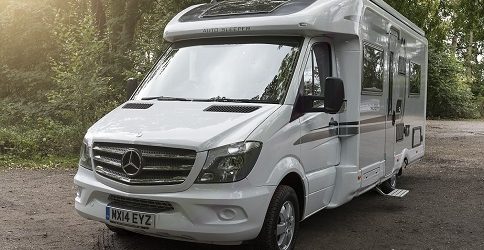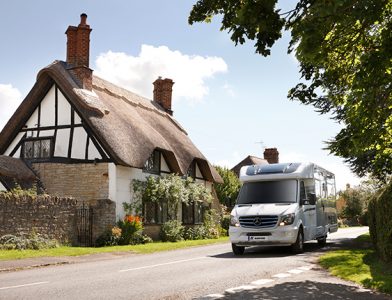Take to the wheel of any motorhome and the freedom of the open road is all yours. Take to the wheel and drive your motorhome in Europe and that open road might seem to have no end in sight.
Whatever time of year you are proposing to go, a little advance planning and attention to what you need to take with you may save heartache – not to mention disaster – further down the road.
So that your adventures on the continent run smoothly and with as little unwelcome incident as possible, however, here are some of the factors to keep in mind – from the planning and paperwork to the preparation of your motorhome, to finally driving in Europe.
Planning
Whether you have a definite destination in mind or are planning for a magical mystery tour to wherever takes your fancy on the day, beware of overly long and tiring hours behind the wheel.
In other words, always plan plenty of pitstops along the way – and that means during the day as well as any overnight stops to sleep.
Your motorhome will be taking the strain, but also needs to be fully fit to do so. In that case, remember to plan an early visit to a servicing agent – ourselves here at Derby Motorhomes, perhaps, especially if yours is an Auto-Sleepers motorhome.
Paperwork
It’s important to have all the documents and paperwork you need to take with you.
Since some of these might take a while to arrange, it’s worth getting them together in good time. Include the following in your checklist of essential documents:
Driving licence
- since the end of the post-Brexit transition, your full UK driving licence remains valid throughout the European Union countries and Iceland, Liechtenstein, Norway and Switzerland;
- if you currently live in any of these countries and have been driving on your UK licence, however, you will need to exchange it for a locally issued licence in accordance with the rules of the country in which you are living;
- in any event, you will need to make sure that your driving licence – including the relevant categories that allow you to drive a motorhome – are up to date;
International Driving Permit (IDP)
- the official advice last updated on the 28th of September 2021 is that you “might” need an IDP if you have a paper driving licence or one that was issued in Gibraltar, Guernsey, Jersey, or the Isle of Man;
- you can also use the government website to check whether you are likely to need an IDP (there are three different types in issue), depending on the countries you’ll be visiting and how long you will be staying in each of them;
- probably the easiest place to get an IDP is the Post Office, where you will need to show your driving licence (and a passport, if your licence is the older, paper type), a current passport-standard photograph, and pay the current £5.50 fee;
Motor insurance
- as the breakdown recovery service Green Flag explains, a minimum of third-party insurance is obligatory throughout Europe, so you need to keep your insurance certificate with you at all times – having checked with your insurer that your policy covers you while driving in Europe;
- you might also want to upgrade any minimum third-party cover provided by your motor insurer when driving in Europe to your normal, fully comprehensive cover;
- as the government-sponsored website Moneyhelper advises, also ask your insurer for a “green card” showing proof that you meet the insurance standards required in the countries through which you will be driving – bearing in mind that a green card typically expires after 90 days;
Passports
- even in the days when you enjoyed freedom of movement within Europe, the best means of identification for you and each of your passengers was your passport – post-Brexit, of course, passports are going to be essential, and you may even need a visa to visit countries within Europe;
- as the long delays at the Port of Dover in the summer of 2022 made clear, the post-Brexit need for European immigration authorities to ensure that visits do not exceed 90 days in any 100 days means that your UK passport now has to be checked and stamped on entry to the EU.
Finally, don’t forget to take proof of ownership of your vehicle – typically satisfied by your Vehicle Registration Certificate, the V5C, or logbook as it’s commonly called.
Preparation
Preparing for your trip to Europe means making sure that your motorhome is ready for the adventure – and that it carries the equipment and any accessories that will be needed by law as you drive through various European countries.
We have already mentioned the importance of a thorough service – inside and out – to ensure that your motorhome is roadworthy and capable of providing reliable and comfortable accommodation for several weeks at a time.
One of the first things you also need to ensure is that a “GB” nationality sticker is fixed to the outside rear of your motorhome – it is required throughout Europe.
Different European countries have different rules about the equipment that must be carried within your motorhome – so check carefully what is required in the countries through which you will be driving.
There is also considerable variation in the local requirements for equipment you need to keep on board – this may include:
Hazard warning triangles
- practically every country requires that you carry a warning triangle – but did you know that in Spain and Croatia you have to carry two;
Reflective jacket
- for use in similar circumstances, you must also have on board a reflective jacket while driving in Spain, Austria, France, Belgium, Portugal, and Croatia;
First aid kit
- in Greece, Germany, France, Croatia, and Austria, you must have a first aid kit on board – although it is a sensible precaution, of course, wherever you happen to be driving;
Fire extinguisher
- a similarly wise precaution is to carry a fire extinguisher within your motorhome – and it is specifically recommended (although not obligatory) in Spain, Portugal, Switzerland, and the Netherlands;
Breathalyser
- in France, you must also carry a breathalyser kit – although it remains a moot point whether the law is rigorously applied, says the RAC.
These are by no means the only local differences you are likely to encounter in the traffic regulations of the countries you are going to be driving through. In guidance updated on the 12th of July 2022, the Money Saving Expert also offers a comprehensive guide to what you will need, as does the AA.
Driving in Europe
The rules of the road in some parts of Europe may be different from those with which you are familiar at home. Despite everything you might have read about the standardisation of rules throughout the EU when it comes to local traffic regulations, there are still important differences in each member country.
You want to stay on the right side of the law, of course, so before you go it is important to research the rules of the road in every country you are going to be visiting (and those you might need to drive through as the result of diversions or other emergencies).
Some of the greatest variations you are likely to encounter are speed limits in different European countries – especially if yours is a larger motorhome. And don’t let variable speed limits catch you out.
In some countries, the rules may be especially quirky and convoluted. In Spain, for example, some one-way streets allow parking on the side of the street where houses have odd numbers on odd days of the month – and the side where house numbers are even, on even days of the month.
Driving your motorhome in Europe expands your horizons, of course, but make sure that you go thoroughly prepared. And, as a final reminder, before you set off on your adventures in a motorhome, just double-check you have all the right documentation.
Please note that the information contained within this blog is based on our current understanding of the law. As legislation can change, we recommend you always make your own checks on documentation and licence requirements etc. before you travel.




